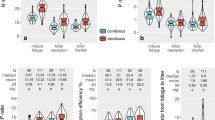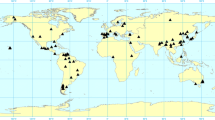Abstract
In this paper, we suggest new nutrient threshold values and ratios for the major nutrients (N, P, K, Ca, Mg) for four main trees species Pinus sylvestris, Picea abies, Fagus sylvatica and Quercus (Q. robur and Q. petraea) statistically derived from the data collection of van den Burg’s literature compilation (1985, 1990), and compare them with widely used central European literature. The comparison is focused on the normal range of nutrition of major elements. We could show that the new critical foliar nutrient concentrations and ratios do not have the imponderabilities of the established reference systems, like restricted calibration range or data gaps for species in general or some major nutrients in particular. Ranges from the new critical foliar nutrient concentrations are generally smaller, except for broadleaves foliar Ca and Mg values, where another reference provides the narrowest ranges. The practicability of the different systems has been exemplary tested on a foliage data set of Norway spruce from the Bavarian soil survey. This application illustrates that an evaluation based on the new nutrient thresholds is in the majority of cases more cautious than the other reference systems. Moreover, evaluations based on the new concentrations and ratios are quite consistent. Comparisons with nutrient ratios related to the susceptibility to parasite attacks show that the thresholds are close to a general optimum range, indicating health and intact resistance mechanisms of these tree species. Uncertainties of the new threshold values as well as the need to further evaluate and develop reference systems for nutrient status of forest trees are discussed.



Similar content being viewed by others
References
Aronsson A (1980) Frost hardiness in Scots pine. II Hardiness during winter and spring in young trees of different mineral status. Studia Forest Suecica 155:1–27
Agren GI (2008) Stoichiometry and nutrition of plant growth in natural communities. Annu Rev Ecol Evol Syst 39:153–170
Bauer G, Schulze ED, Mund M (1997) Nutrient contents and concentrations in relation to growth of Picea abies and Fagus sylvatica along a European transect. Tree Physiol 17:777–786
Bergmann W (1993) Ernährungsstörungen bei Kulturpflanzen. 3.Aufl., Gustav Fischer Verlag, Jena.835 S
BML (2000) Kennwerte zur Charakterisierung des ökochemischen Bodenzustandes und des Gefährdungspotentials durch Bodenversauerung und Stickstoffsättigung an Level II-Waldökosystem-Dauerbeobachtungsflächen, Bonn, Arbeitskreis C der Bund-Länder Arbeitsgruppe Level II, 167 S
Brække FH, Salih N (2002) Reliability of foliar analyses of Norway spruce stands in a Nordic gradient. Silva Fenn. 36:489–504
Cape JN, Freer-Smith PH, Paterson IS, Parkinson J, Wolfenden J (1990) The nutritional status of Picea abies (L.) Karst. across Europe, and implications for “forest decline”. Trees Struct Funct 4:211–224
DeVries W, Kros H, Reinds G J, van Dobben H, Bobbink R, Emmet B, Smart S, Evans C, Schlutow A, Kraft P, Belyazid S, Sverdrup H, Hinsberg A, Posch M, Hetterlingh J-P (2007) Developments in deriving critical limits and modelling critical loads of nitrogen for terrestrial ecosystems in Europe, Alterra Rapport 1382
Duquesnay A, Dupouey JL, Clement A, Ulrich E, Le Tacon F (2000) Spatial and temporal variability of foliar mineral concentration in Beech (Fagus sylvatica) stands in northeastern France. Tree Physiol 20:13–22
Ewald J (2005) Ecological background of crown condition, growth and nutritional status of Picea abies (L.) Karst. in the Bavarian Alps. Eur J For Res 124:55–66
Fiedler HJ, Nebe W, Hoffmann F (1973) Forstliche Pflanzenernährung und Düngung. Gustav Fischer V Stuttgart. 481 p
Fischer R, Lorenz M, Granke O, Mues V, Iost S, van Dobben H, Reinds GJ, de Vries W (2010) Forest condition in Europe: 2010 technical report of ICP forests. Hamburg: vTI, 175 Seiten, Work report of the Institute for World Forestry 2010/01
Flückiger W, Braun S (1999) Nitrogen and its effects on growth, nutrient status and parasite attacks in beech and Norway Spruce. Water Air Soil Pollut 116:99–110
Flückiger W, Braun S (2003) Critical limits for concentrations and ratios for forest trees—a comment. http://www.iap.ch/publikationen/proceedings_cln_2003_p273-280.pdf
Göttlein A, Baier R, Mellert KH (2011) Neue Ernährungskennwerte für die forstlichen Hauptbaumarten in Mitteleuropa—Eine statistische Herleitung aus van den Burg`s Literaturzusammenstellung. Allg Forst Jagd Z (accepted)
Gulder HJ, Kölbel M (1993) Waldbodeninventur in Bayern. Forstl Forsch Ber Mchn 132:243
Heinsdorf D (1965) Über den Ernährungszustand von Kiefernkulturen auf Sandböden in Jahren mit unterschiedlichen Niederschlägen (1961–1963). Archiv für Forstwesen Bd. 15:1966
Heinsdorf D (1993) The role of nitrogen in declining Scots pine forests (Pinus sylvestris) in the lowland of East Germany. Water Air Soil Pollut 69:21–35
Heinsdorf D (1999) Düngung von Forstkulturen auf Lausitzer Kippen LAUBAG Eberswalde, p 54
Hüttl RF (1990) Nutrient supply and fertilizer experiments in view of N saturation. Plant Soil 128:45–58
Hüttl RF (1992) Die Blattanalyse als Diagnose- und Monitoringinstrument in Waldökosystemen. Freiburger Bodenkundl. Abhandlungen 30:31–59
Ingestad T (1979) Mineral nutrient requirements of Pinus sylvestris and Picea abies seedlings. Physiol Plant 45:373
Ingestad T (1987) New concepts on soil fertility and plant nutrition as illustrated by research on forest trees and stands. Geoderma 40:237–252
Krauß HH, Heinsdorf D (2005) Ernährungsstufen für wichtige Wirtschaftsbaumarten. Beitr. Forstwirtschaft u. Landschaftsökologie 39:172–179
Laatsch W (1967) Beziehungen zwischen Standort, Ernährungszustand und Wuchsleistung von Kiefernaufforstungen im Mittelgebirge. Forstwiss Cbl 86:69–81
Larcher W (1994) Ökophysiologie der Pflanzen. 5. Aufl., Ulmer Verlag Stuttgart
Linder S (1995) Foliar analysis for detecting and correcting nutrient imbalances in Norway spruce. Ecol Bull 44:178–190
Mellert KH, Prietzel J, Straussberger R, Rehfuess KE (2004a) Relationships between recent changes of tree growth in two Bavarian Scots Pine (Pinus sylvestris) stands and the temporal variation of stand nutrition and climate. Austrian J For Res 121:141–166
Mellert KH, Prietzel J, Straussberger R, Rehfuess KE (2004b) Long-term nutritional trends of conifer stands in Europe—Results from the RECOGNITION project. Eur J For Res 123:305–319
Mellert KH, Prietzel J, Straussberger R, Rehfuess KE, Kahle HP, Spiecker H (2008) Relationships between long-term trends of air temperature, precipitation, nitrogen nutrition and growth of coniferous stands in Central Europe and Finland. Eur J For Res 127:507–524
Moore JD, Camire C, Ouimet R (2000) Effects of liming on the nutrition, vigor and growth of sugar maple at the Lake Clair watershed, Quebec, Canada. Can J For Res 30(5):725–732
Musio M, von Wilpert K, Augustin HE (2007) Crown condition as a function of soil, site and tree characteristics. Eur J For Res 126:91–100
Pitman R, Bastrup-Birk A, Breda N, Rautio P (2010) Sampling and Analysis of Litterfall. Manual Part XI. In: Manual on methods and criteria for harmonized sampling, assessment, monitoring and analysis of the effects of air pollution on forests. http://http//www.icp-forests.org/pdf/FINAL_Litter.pdf
Prevot P, Ollagnier M (1957) Méthodes d’utilisation di diagnostic foliare. In: Analyse des plantes et problème des fumures minerals (IRHO) Paris 1957; 236 p
Prietzel J, Rehfuess KE, Stetter U, Pretzsch H (2008) Changes of soil chemistry, stand nutrition, and stand growth at two Scots pine (Pinus sylvestris L.) sites in Central Europe during forty years after fertilization, liming, and lupine introduction. Eur J For Res 127:43–61
Reemtsma JB (1986) Der Magnesiumgehalt von Nadeln niedersächsischer Fichtenbestände und seine Beurteilung. AFJZ 157:196–203
Rehfuess KE (1968) Beziehungen zwischen dem Ernährungszustand und der Wuchsleistung südwestdeutscher Tannenbestände (Abies alba Mill.). Forstwiss Cbl 87:36–58
Riek W, Russ A, Martin J (2011) Ernährungszustand der Kiefer—Ergebnisse der BZE in Brandenburg und Mecklenburg-Vorpommern. Jahrestagung der DVFFA, Sektion Waldernährung, 4.-6.Mai 2011, Bamberg
Roelofs JG, Kempers AJ, Houdijk AL, Jansen J (1985) The effect of airborne ammonium sulphate on Pinus nigra var. maritima in the Netherlands. Plant Soil 84:45–56
Rothe A, Binkley D (2001) Nutritional interactions in mixed species forests: a synthesis. Can J For Res 31:1855–1870
Smith PF (1962) Mineral analysis of plant tissues. Ann Rev Plant Physiol 13:81–108
Stefan K, Fürst A, Hacker R, Bartels U (1997) Forest foliar condition in Europe. Results of large-scale foliar chemistry surveys. European Commission—United Nations/Economic Commission for Europe, Brussels
StMELF (1987) Grundsätze für die Düngung im Wald. Bayerisches Staatsministerium f. Ernährung, Landwirtschaft u. Forsten, München
Strebel O (1958) Mineralstoffernährung und Wuchsleistung von Fichtenbeständen (Picea abies) in Bayern. Forstwiss Cbl 79:17–42
Tamm CO (1951) Seasonal variation in composition of birch leaves. Physiol Plantarum, Kopenhagen, pp 461–469
Toms JD, Lesperance ML (2003) Piecewise regression: a tool for identifying ecological thresholds. Ecology 84:2034–2041
Tukey JW (1977) Exploratory data analysis. Addison-Wesley, ISBN 0-201-07616-0
van den Burg J (1985) Foliar analysis for determination of tree nutrient status—A compilation of literature data. Rijksinstituut voor onderzoek in de bos- en landschapsbouw „de Dorschkamp“, Wageningen, Niederlande
van den Burg J (1988) Voorlopige criteria voor de beoordeling van de minerale-voedingstoestand van naaldboomsoorten op basis van de naaldsamenstelling in het najaar. Wageningen, Rijksinstituut voor onderzoek in de bos- en landschapsbouw “De Dorschkamp”. Rapport 522
van den Burg J (1990) Foliar analysis for determination of tree nutrient status—A compilation of literature data; 2. Literature 1985–1989. „de Dorschkamp“ Institute for Forestry and Urban Ecology, Wageningen, Niederlande
Weber-Blaschke G, Heitz R, Blaschke M, Ammer C (2008) Growth and nutrition of young European ash (Fraxinus excelsior L.) and sycamore maple (Acer pseudoplatanus L.) on sites with different nutrient and water statuses. Eur J For Res 127:465–479
Wehrmann J (1959) Methodische Untersuchung zur Durchführung von Nadelanalysen in Kiefernbeständen. Forstwiss Centralbl 78:77–97
Wehrmann J (1961) Die Auswirkung der Trockenheit von 1959 auf die Nährelementversorgung bayerischer Kiefernbestände, Forstwiss. Cbl. 80
Wolff B, Riek W (1997) Deutscher Waldbodenbericht 1997. Ergebnisse der bundesweiten Bodenzustandserhebung im Wald 1987–1993 (BZE). Bd. 1, Bd. 2. Bundesministerium für Ernährung, Landwirtschaft und Forsten (BML) (Hrsg.). Bonn
Acknowledgments
We are indebted to Roland Baier for valuable contributions to the van den Burg database. We thank Christian Kölling from the Bavarian State Institute of Forestry for providing the Level-I data. The study was co-financed by Johann Heinrich von Thünen-Insitut (vTI), Institut für Waldökologie und Waldinventuren (WOI), Eberswalde.
Author information
Authors and Affiliations
Corresponding author
Additional information
Communicated by A. Merino.
Rights and permissions
About this article
Cite this article
Mellert, K.H., Göttlein, A. Comparison of new foliar nutrient thresholds derived from van den Burg’s literature compilation with established central European references. Eur J Forest Res 131, 1461–1472 (2012). https://doi.org/10.1007/s10342-012-0615-8
Received:
Revised:
Accepted:
Published:
Issue Date:
DOI: https://doi.org/10.1007/s10342-012-0615-8




